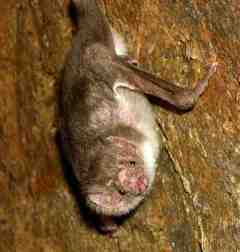|
The Vampire Bat - The Myths And FactsAre you feeling a bit squeamish about the vampire bat? (The photo's of a common one and is from Wikimedia Commons).
Horror movies have led to all kinds of negative thoughts and feelings about them. Although their diet might sound a bit gross, there are many positive and surprising things about them too. So let's start by dispelling some of the myths that surround them... Myth 1: They kill living creatures by sucking all the blood out of them. Fact: It's true that their diet consists solely of blood (hematophagy). But rather than suck, they lap up the blood and take no more than 2 tablespoons (which is about half their body weight). This usually isn't harmful to the host unless several of them take blood from the same animal on the same night. Myth 2: They're pretty big. Fact: Unlike the bats that are sometimes used in horror films, a real vampire bat is small. They grow to the length of a human adult thumb and have a wingspan of 20 to 30 cm (8 to 12 inches). Weight-wise, they're between 28 to 40 g (around 1 to 1.5 oz). Myth 3: They are found in Transylvania. Fact: There are only 3 species of this kind of bat and they're all found in Central and South America. They're known as the Common (Desmodus rotundus), the White-Winged(Diaemus youngi) and the Hairy-Legged (Diphylla ecaudata) vampire bats. Myth 4: They'll fly out of the night and attack you! Fact: They only take blood from sleeping animals. Their brains have evolved to be sensitive to the breathing patterns that signal that a being is asleep. And their heat sensors mean that they can easily detect where the blood is flowing close to the surface of a potential host. A combination of chemicals in their saliva means that:
It's true that they'll sometimes take blood from humans, but this is pretty rare. Depending on species, their usual food sources are cattle, birds, goats, horses and pigs. Did you know that...
these bats will share their food with other members (related or unrelated) of their colony who weren't able to get a meal? unlike other bats, they can also walk, hop and run? They're also really good at taking off from the ground. They use their thumbs to propel themselves into the air and can get to a height of 1.2 m (4 feet)! So how are you feeling about this species of bat now? A bit better I hope :-) Desmodus rotundus - The Common Vampire Bat
|







